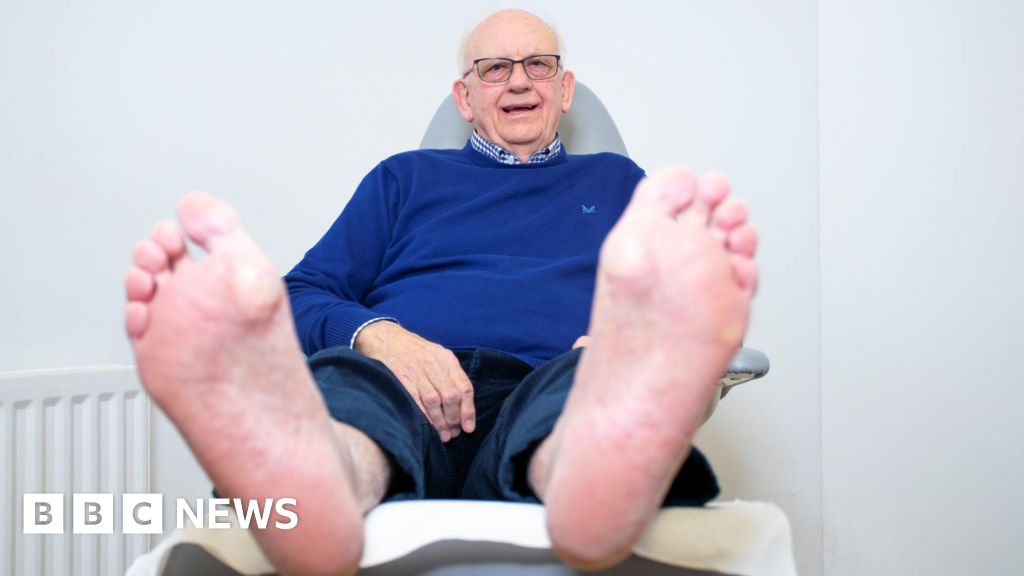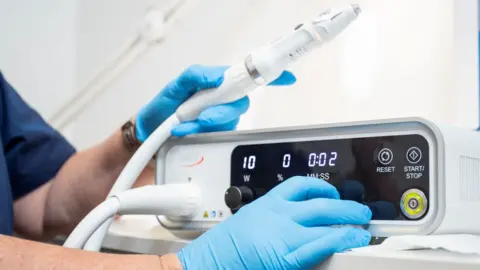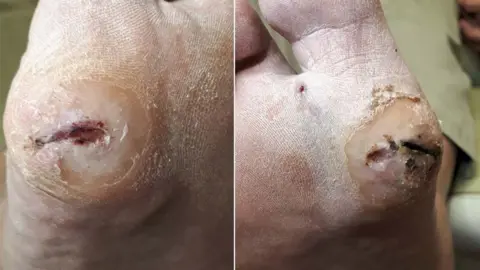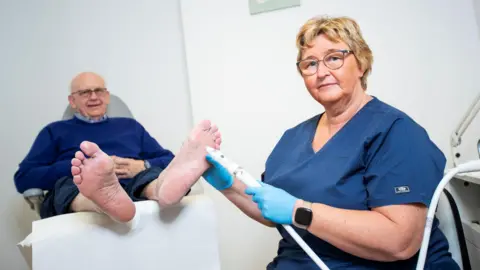Tech
Scottish technology saves diabetic man from double leg amputation

 Emblation
EmblationA diabetic patient has had both legs saved from amputation by new microwave technology.
Barry Mayled, 74, has type two diabetes and watched foot ulcers steadily worsen during the Covid pandemic until surgeons said they had no choice but to amputate.
But Mr Mayled said a medical student observing his care mentioned microwave treatment as an option and, following nine months of treatment, he is now “totally clear”.
His “severely ulcerated” feet were treated using Swift, a microwave technology developed by Stirling-based Emblation.
It uses low energy doses of microwaves to stimulate the immune system.
Warning: This story contains graphic images
The architect and gardener, from Penarth in the Vale of Glamorgan, said he wanted to continue working and have a good quality of life during retirement.
But he admitted the prospect of losing his legs “doesn’t bare thinking about”.
Mr Mayled said: “It saved my life. I’m still working and I’m on building sites and everything, and without my legs, that would have been the end of it.
“As a sole practitioner, my career would have ended if the amputations were carried out.
“At one point I was in hospital surrounded by medics and things were so bad that the main surgeon was just shaking his head.
“There was pretty much nothing left to try and it was a matter of ‘when’ not ‘if’ my legs would have to be amputated below the knees.”
He credits Tracey Davies, of Toetal Footcare, for identifying the problem.
 Emblation
EmblationMr Mayled initially thought he had a bruise which grew while on holiday and “burst”.
But he was then diagnosed with an ulcer which, over time, spread to both feet.
Leg amputations are a known complication of diabetes which can cause reduced blood flow and nerve damage in the lower limbs.
As a result, wounds, ulcers and infections can become gangrenous.
“This went on for about two years, trying to clean this ulcer up by which time Covid came along.” he said
“We were left a little bit high and dry and it transpired this was getting worse and worse to the point where I could hardly walk.
“The only bit of luck I had was in this grouping around me which was made up of wound clinic podiatrists, there was a student just observing.
“She said what about microwave treatment and they turned around and virtually silenced her with their eyes because the NHS do not use microwave treatment to treat what turned out to be a diabetic ulcer with underlying verruca tissue.”

Mr Mayled, who was treated by Ms Davies at Toetal Footcare in Cardiff, received seven applications of the Swift microwave technology on five areas of his right foot and three on his left.
Ms Davies said Mr Mayled received excellent wound care from the NHS but Swift provided an alternative way to address the problem.
She said: “Quite frankly we had nothing to lose.
“Barry’s case has highlighted verrucae infection as a possible cause of foot ulcerations failing to heal and has increased the possibilities of using Swift in such cases.
“This could be far-reaching in the treatment of non-healing foot ulcerations, thus preventing unnecessary amputations.”
The expert said she was “amazed” by the “remarkable turnaround”.
She said: “My business partner and I have both been HCPC-registered podiatrists for more than 40 years and Swift has shown the most effective treatment outcomes for verrucae we have treated to date.”
 Emblation
EmblationSwift was developed in 2016 by scientists Gary Beale and Eamon McErlean, who met while studying at Heriot-Watt University in Edinburgh.
The pair then teamed up to launch parent company Emblation, based in Stirling.
The Swift device has been used by podiatrists across the world to treat verrucae and plantar warts with medical testing being carried out to test its use in treating other conditions and lesions, like basal cell carcinoma.
Gary Beale, chief executive of Emblation, said Barry’s story was “truly inspiring” and described the company’s technology as “game-changing”.











